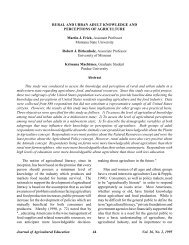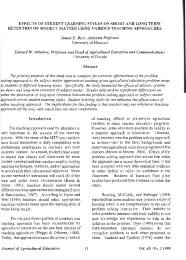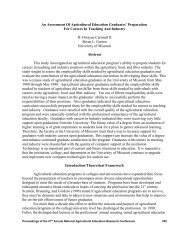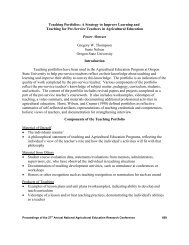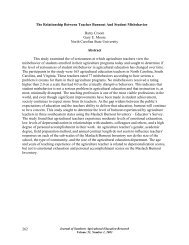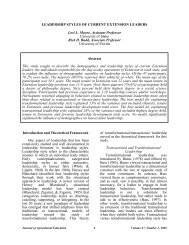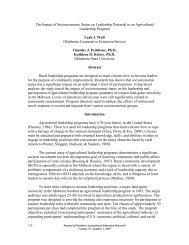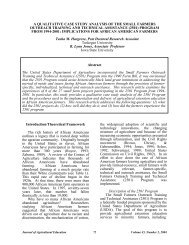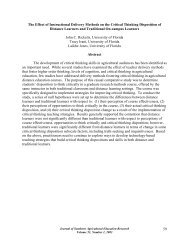Relationships Between Critical and Creative Thinking - Agricultural ...
Relationships Between Critical and Creative Thinking - Agricultural ...
Relationships Between Critical and Creative Thinking - Agricultural ...
You also want an ePaper? Increase the reach of your titles
YUMPU automatically turns print PDFs into web optimized ePapers that Google loves.
The following descriptions of the CCTDI constructs are from the CCTDI test manual(Facione, Facione, & Giancarlo, 1996).Analyticity is a construct consisting of 11 items from the CCTDI. This construct targetsthe disposition of being alert to potentially problematic situations, anticipating possible results orconsequences, <strong>and</strong> prizing the application of reason <strong>and</strong> the use of evidence even if the problemat h<strong>and</strong> turns out to be challenging or difficult. The analytically inclined person is alert topotential difficulties, either conceptual or behavior, <strong>and</strong> consistently looks to anticipatoryintervention, reason giving, <strong>and</strong> fact-finding as effective ways to resolve matters.Self-confidence is a construct consisting of 9 items from the CCTDI. This construct refersto the level of trust one places in one’s own reasoning process. <strong>Critical</strong>ly thinking, self-confidentpersons trust themselves to make good judgments <strong>and</strong> believe that others trust them as well,since they believe that others look to them to resolve problems, decide what to do, <strong>and</strong> bringreasonable closure to inquiry.Inquisitiveness is a construct consisting of 10 items from the CCTDI. The inquisitiveperson is one who values being well informed, wants to know how things work, <strong>and</strong> valueslearning even if the immediate payoff is not directly evident.Maturity is a construct consisting of 10 items from the CCTDI. The maturity scaleaddresses cognitive maturity <strong>and</strong> epistemic development. CCTDI scoring gives preference tothose disposed to approach problems, inquiry, <strong>and</strong> decision making with a sense that someproblems are ill-structured, some situations admit of more than one plausible option, <strong>and</strong> manytimes judgments based on st<strong>and</strong>ards, contexts, <strong>and</strong> evidence which precludes certainty must bemade.Open-mindedness is a construct consisting of 12 items from the CCTDI. This constructtargets the disposition of being open-minded <strong>and</strong> tolerant of divergent views with sensitivity tothe possibility of one’s own bias. The open-minded person respects the rights of others toholding differing opinions.Systematicity is a construct consisting of 11 items from the CCTDI, targeting thedisposition to being organized, orderly, focused, <strong>and</strong> diligent in inquiry. No particular kind oforganization, e.g. linear or nonlinear, is given priority on the CCTDI. The systematic personstrives to approach specific issues, questions or problems in an orderly, focused, <strong>and</strong> diligentway, however that might be accomplished.Truth-seeking is a construct consisting of 12 items from the CCTDI, representative ofthose eager to seek the truth, who are courageous about asking questions, <strong>and</strong> honest <strong>and</strong>objective about pursuing inquiry even if the findings do not support one’s interests or one’spreconceived opinions. The truth-seeker would rather pursue the truth than win the argument.Total Score is a measure consisting of the 75 items from the CCTDI.180 Journal of Southern <strong>Agricultural</strong> Education ResearchVolume 51, Number 1, 2001




